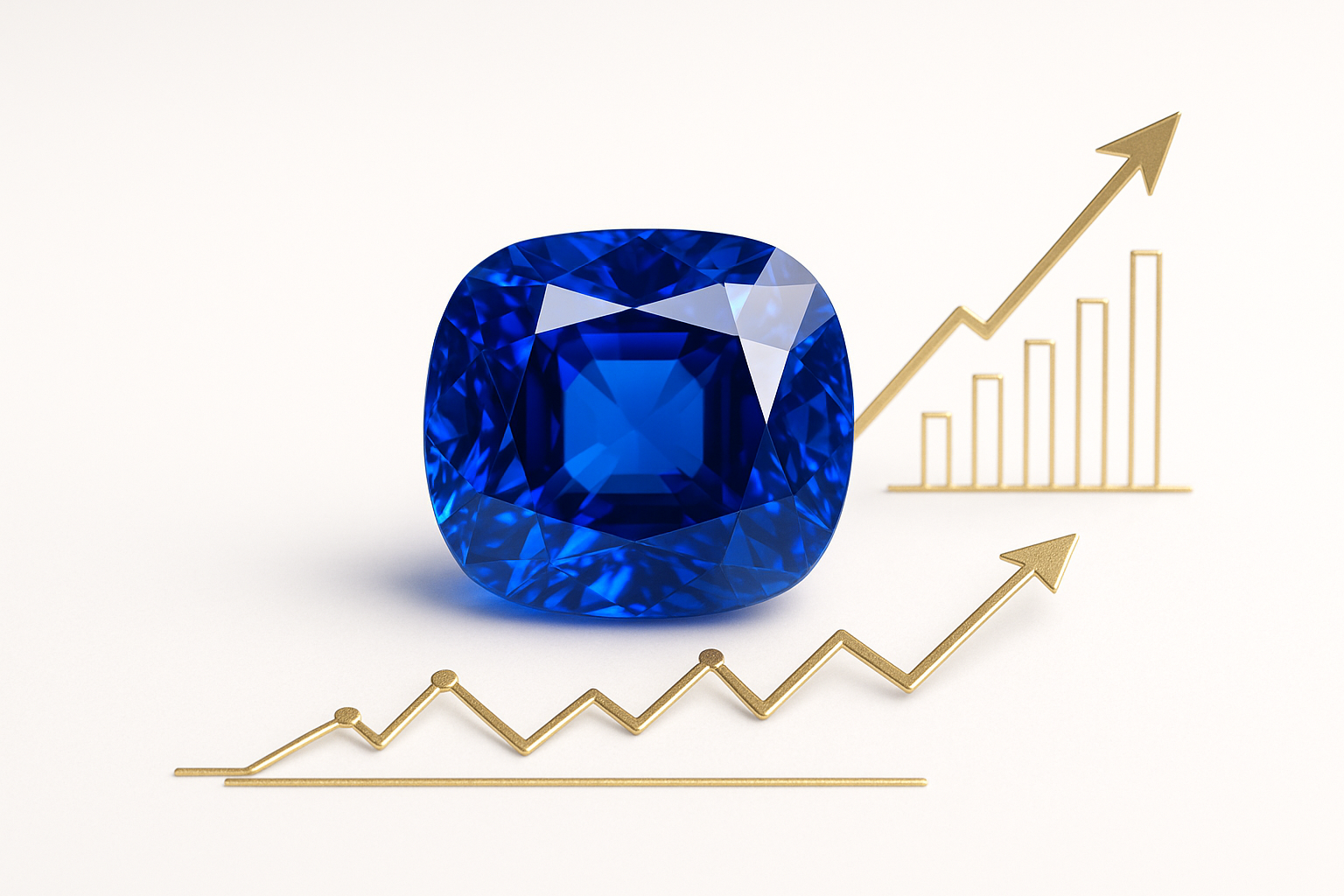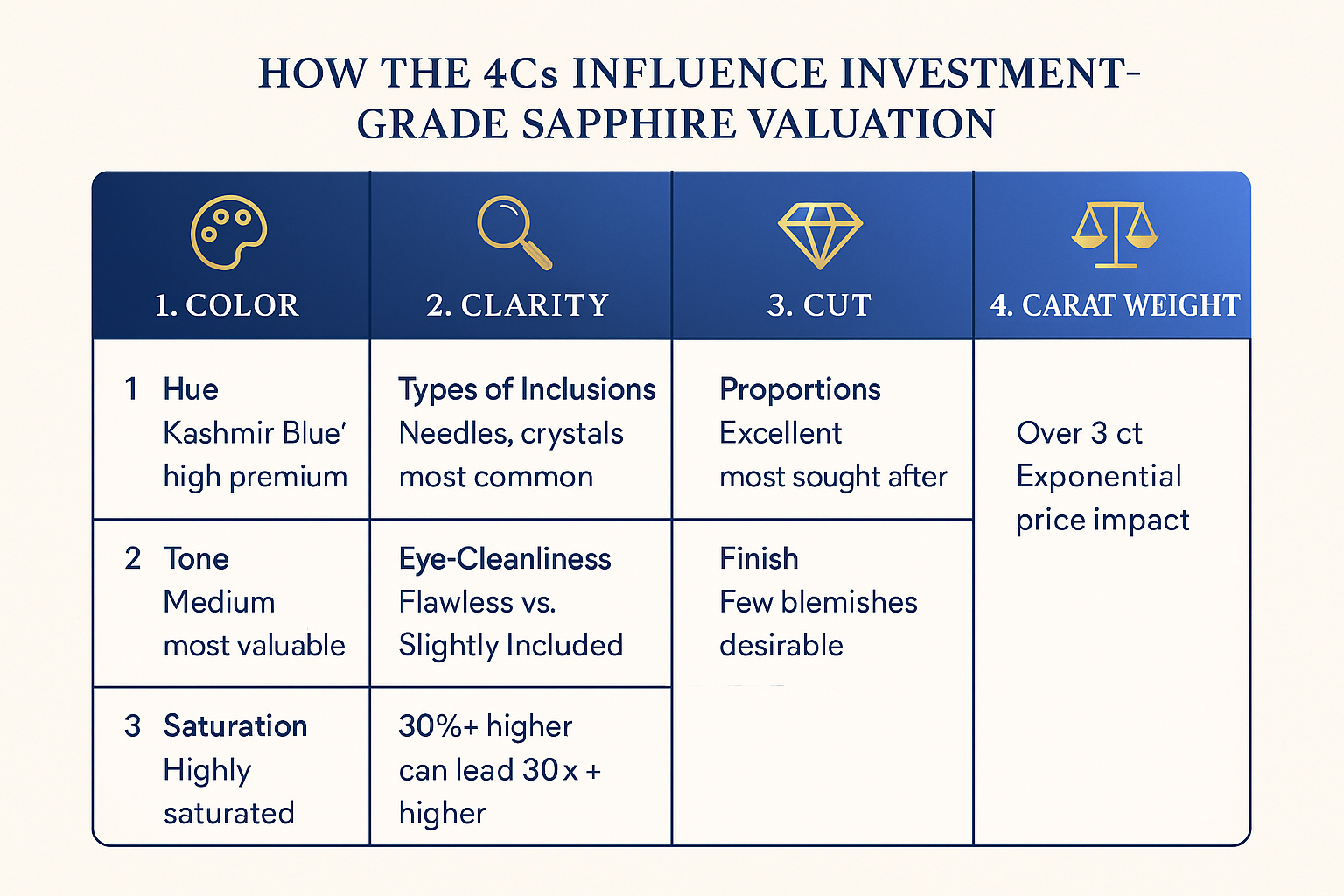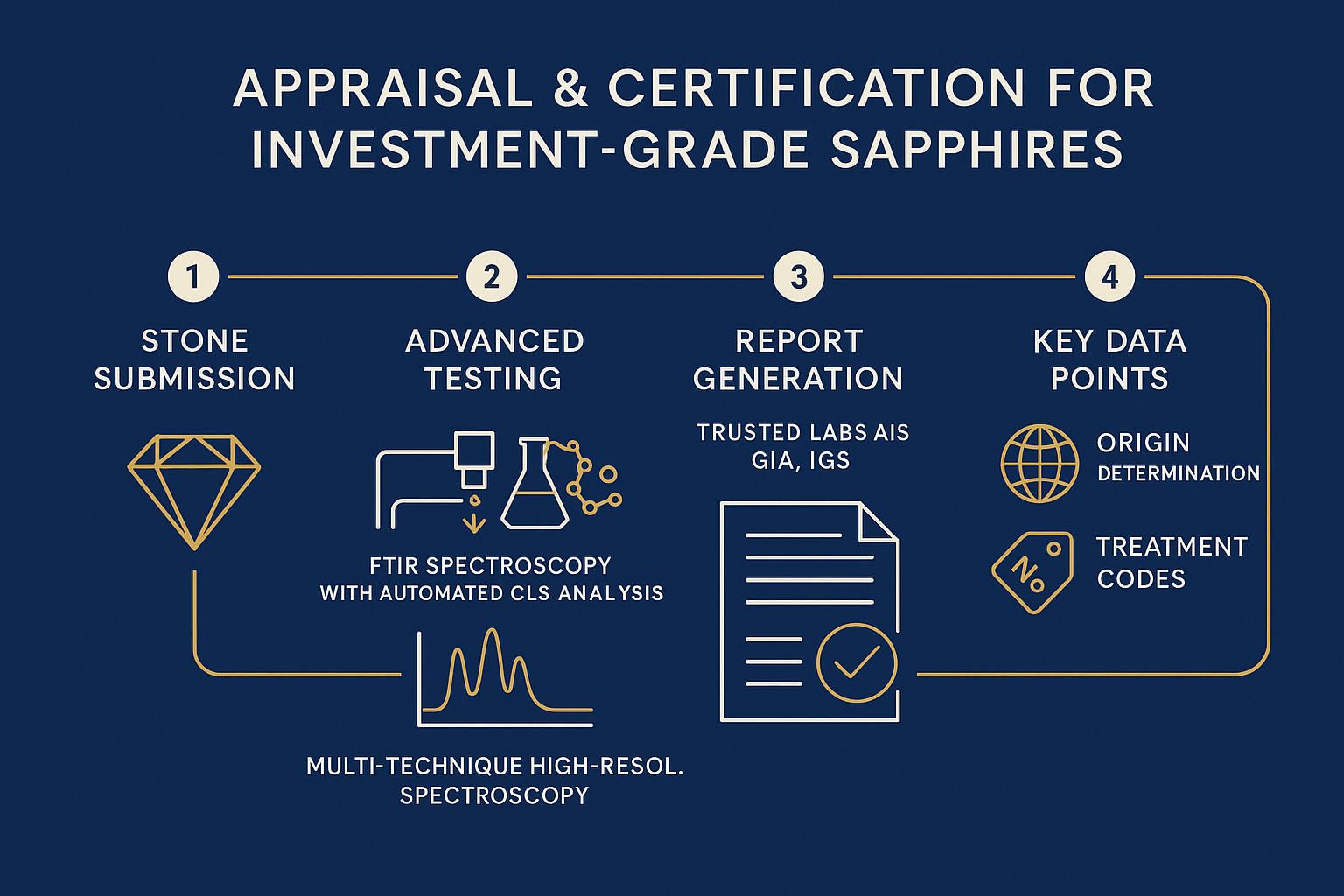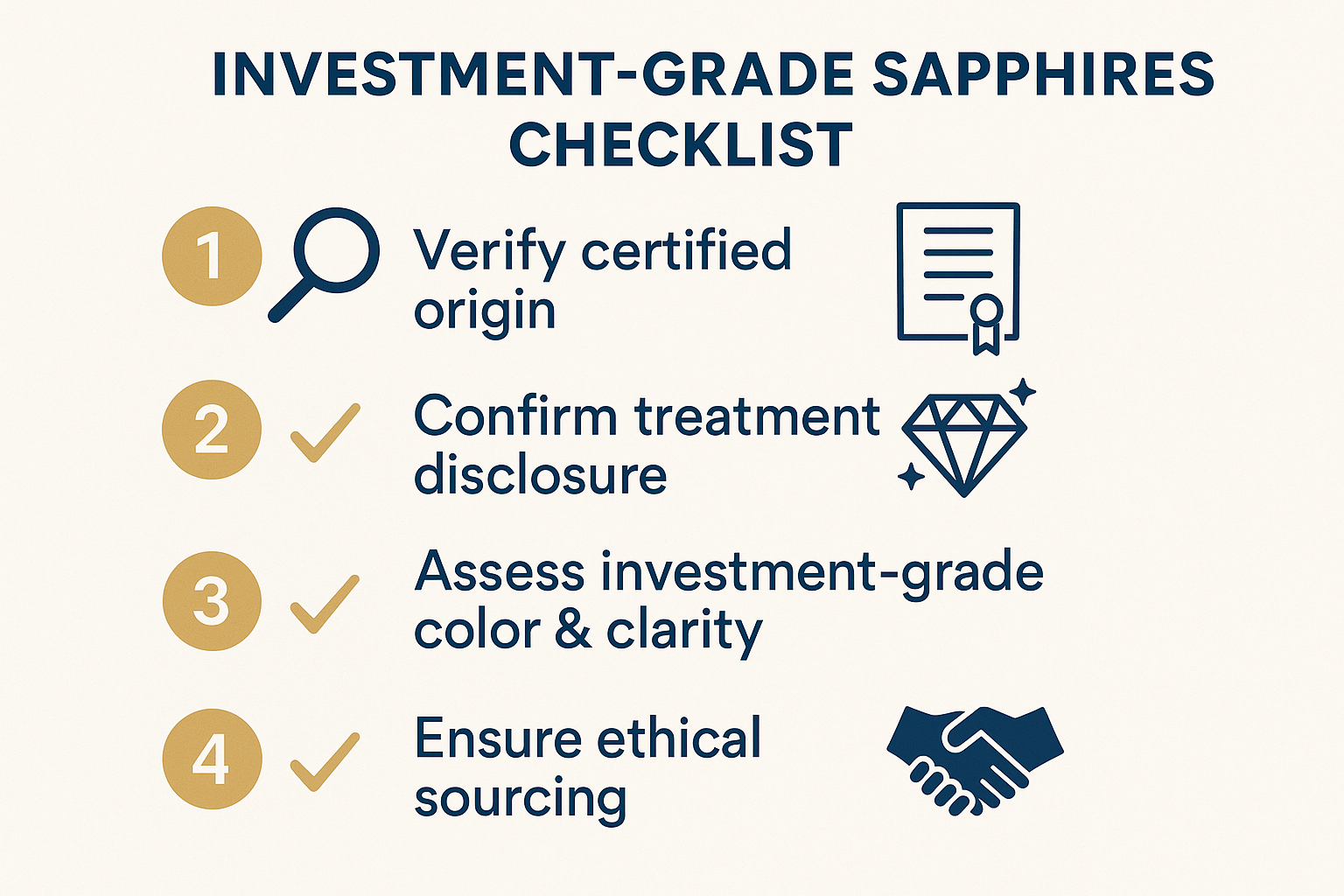
Your opinion is important to us!
Help us improve by filling our quick survey

Mins Read
|
October 6, 2025
Deciding to invest in a sapphire is a significant step. You're moving beyond appreciating a beautiful gemstone and into the world of tangible assets—a market projected to grow from $2.16 billion to over $15 billion by 2033. But in this sophisticated market, how do you distinguish a beautiful stone from a genuine investment-grade asset?
The standard "4Cs" are just the starting point. True valuation requires a deeper understanding of the methodologies used by gemologists and market experts. It’s about learning to see a sapphire not just for its color, but for its provenance, its purity, and its potential for long-term value appreciation. This guide provides the framework you need to evaluate these assets with confidence, ensuring your investment is as sound as it is stunning.
For investors, the 4Cs (Color, Clarity, Cut, Carat) aren't just descriptive terms; they are critical value drivers that must be weighed with a more discerning eye. Their interplay determines whether a sapphire has the potential to see the 18-25% annual price increases observed in premium stones from 2020-2024.

Color is paramount. For an investment-grade stone, we look for a perfect balance of three elements:
Certain colors command significant premiums. The legendary velvety blue of a Kashmir sapphire, the coveted "cornflower blue" of a fine Ceylon (Sri Lankan) stone, or the exceptionally rare pink-orange hue of a Padparadscha sapphire are all hallmarks of top-tier investments.
While an "eye-clean" stone—one with no inclusions visible to the naked eye—is the baseline, an investor's assessment of clarity goes deeper. A detailed sapphire clarity chart helps differentiate grades. However, some inclusions can actually increase value. The fine, rutile silk inclusions in a Kashmir sapphire create its signature velvety appearance and serve as proof of its prized origin. Conversely, inclusions that compromise the stone's durability, like large surface-reaching fractures, will significantly detract from its investment potential.
The cut of an investment-grade sapphire is less about a fashionable shape and more about maximizing its intrinsic beauty and value. A masterful cut enhances the stone's brilliance, minimizes color zoning (uneven color distribution), and retains as much of the original carat weight as possible. Poor cutting can lead to a "window" (a lifeless area in the center) or a "belly" (excess weight on the pavilion), both of which negatively impact value.
Value in sapphires doesn't increase linearly with weight; it increases exponentially. A single 5-carat sapphire of exceptional quality is worth far more than five 1-carat sapphires of the same quality. This is because large, high-quality rough sapphire is exceedingly rare. As stones pass key size thresholds (3, 5, and 10 carats), the price-per-carat can jump dramatically. Referencing a sapphire size chart can help you visualize these critical size differences.
A sapphire's geographic origin is a critical part of its story and its valuation. Certain locations are famed for producing sapphires of unparalleled quality, and this provenance, when verified, adds a significant premium.
Crucially, the demand for transparently sourced, ethical gemstones is becoming a value driver in itself. A stone with a documented, ethical journey from mine to market not only offers peace of mind but also appeals to a growing segment of conscientious buyers, enhancing its long-term desirability.
The vast majority of sapphires on the market undergo some form of treatment to improve their color or clarity. From an investment perspective, understanding these treatments is non-negotiable.
Learning how to tell if a gemstone is real and untreated is a foundational skill, but for high-value assets, this determination must be left to a professional gemological laboratory.
For any serious sapphire investment, an independent gemological report is not optional—it is the cornerstone of your due diligence. Certificates from respected labs like the Gemological Institute of America (GIA) provide an unbiased assessment of a stone's identity, origin, and any detectable treatments.

However, a standard report often isn't enough. Top-tier investment valuation relies on advanced analytical methods that provide irrefutable data about a stone's authenticity and origin. This is where you move from basic evaluation to expert-level confidence:
An investor doesn't need to be a scientist, but you must demand this level of scrutiny. A report that includes these advanced tests provides the verifiable proof needed to secure a high-value asset.
With rare sapphires forecast to exceed $5,000 per carat by 2025—outperforming many traditional assets—they represent a powerful tool for wealth preservation and diversification. For those investing in gemstones, sapphires offer a unique combination of beauty, rarity, and durability.
However, like any investment, it carries risks. Illiquidity can be a concern for highly niche stones, and the market is not immune to fraud or misrepresentation. Mitigation strategies are key:
Navigating the complexities of sapphire valuation requires a systematic approach. Use this checklist as a guide during your evaluation process to ensure every critical factor is considered.

Working with a partner who understands these nuances is crucial. At Ceylons, we provide full transparency on our supply chain, from our own eco-friendly mines in Sri Lanka to your hands. We specialize in sourcing investment-grade sapphires and provide the documentation and expert guidance needed to make a confident and secure purchase.
Are sapphires a better investment than diamonds or gold?
Sapphires offer a different value proposition. While gold is a highly liquid commodity, rare, high-quality sapphires have shown greater percentage gains in recent years due to their extreme rarity. Unlike diamonds, which have a more standardized pricing structure (Rapaport), the sapphire market is more nuanced, creating opportunities for knowledgeable investors to acquire undervalued assets.
How liquid is an investment-grade sapphire?
While not as liquid as stocks or gold, top-quality sapphires with proper certification are highly sought after in the global market. Auction houses, private dealers, and jewelers are consistent buyers for fine, unheated stones from classic origins. The key to liquidity is quality and documentation.
What is the single most important factor for a sapphire's investment value?
While all factors are important, color is the most significant driver of value, followed closely by the absence of heat treatment. A vivid, saturated color in a natural, unheated stone is the foundation of any great sapphire investment.
Is a heated sapphire still a good investment?
A heated sapphire can still be a good purchase and may appreciate in value, but its investment ceiling will always be far lower than a comparable unheated stone. For a portfolio focused on the highest potential returns, unheated sapphires should be the priority.
How can I be sure a sapphire's origin claim is authentic?
Never rely on a seller's word alone. The only way to be certain is through a report from a major gemological laboratory (like GIA, SSEF, or Gübelin) that performs advanced origin determination testing. These labs have the reference data and technology to identify the chemical signatures unique to specific geographic locations.
Valuing an investment-grade sapphire is a blend of science and connoisseurship. By understanding the deeper nuances of the 4Cs, the critical importance of origin and treatments, and the security provided by advanced gemological reports, you can navigate the market with confidence.
Explore our collection of ethically sourced, investment-grade sapphires at Ceylons Webshop or contact our specialists to begin building your tangible asset portfolio today.
Sign up to our newsletter now and get it directly to your mailbox.
CEYLONS | MUNICH stands for the finest Ceylon sapphires. A brand committed to responsible mining of Sri Lankan gemstones obtained in an ethical manner.